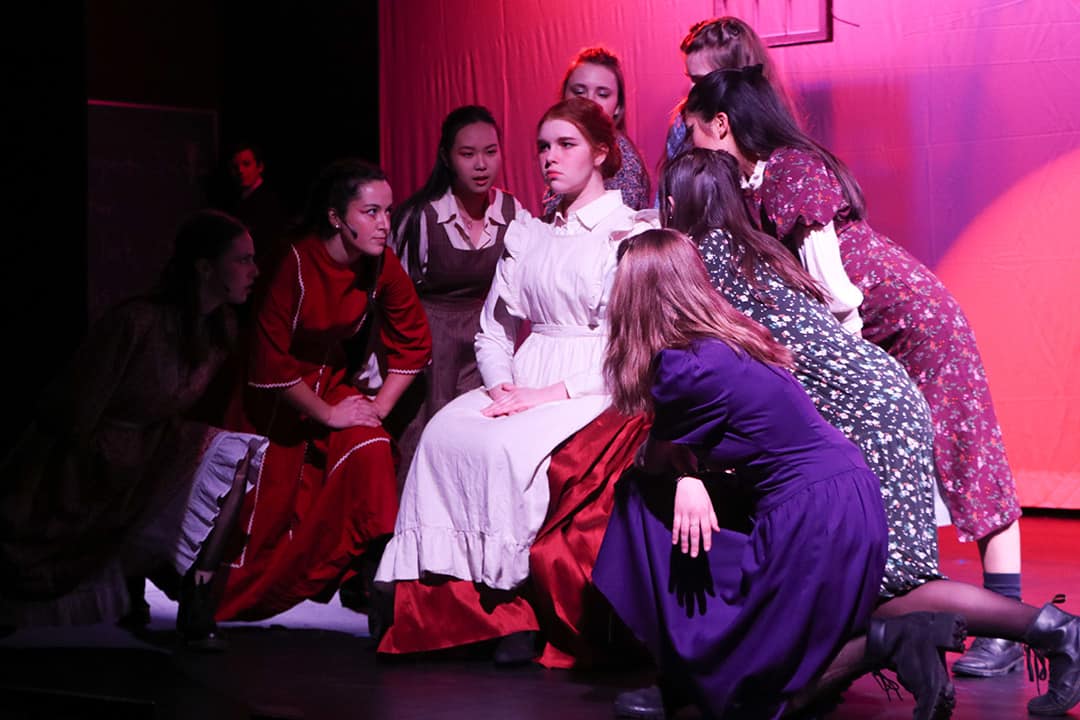Content warning: This article mentions suicide.
After two years, the St. Michael’s College Troubadours (SMCT) have returned with their first in-person musical. The production, performed on March 25 and 26 at the Young Centre for Performing Arts, was an adaptation of the 2006 coming-of-age rock musical Spring Awakening.
Set in late nineteenth century Germany, Spring Awakening explores the stories of teenagers who are navigating their sexualities. Its plot immerses the audience in a navigation of adolescence and young love.
Before the show started, audience members were offered a glimpse into the world portrayed in Spring Awakening through the set. Designed by Emelia Findlay, the staging was minimal but spacious — instead of featuring a variety of backdrops and props to mark the location of each scene, they opted to feature small, interchangeable props for a quick transition between scenes. For example, when characters were supposed to be located outside, audience members witnessed what appeared to be twigs swaying from ceilings. When characters were supposed to be inside a classroom, the set changed to feature a chalkboard and chairs.
In contrast to its subtle set, Spring Awakening started with a bang; immediately, the audience was introduced to the character of Wendla Bergmann, performed by Kasey Belding. Belding starts with a soft and beautiful solo of “Mama Who Bore Me,” during which her character asks her mother why she hasn’t given her information about sex that — later in the musical — could have prevented her from getting pregnant. Throughout the song, Belding’s tone is curious, which is fitting for their character, an innocent girl.
The performance of “The Bitch of Living” was also particularly effective. During the number, numerous men characters sang about the struggle of maturing during adolescence. The performances were high-energy and featured animated facial expressions. One actor really stood out: Daniel Goldman, who played the character Hänschen. Goldman expressed his character’s flamboyant personality by accentuating his movements while dancing.
Another standout moment took place during the smashing performance of “And Then There Were None,” during which the character of Moritz contemplates suicide to flee from his abusive father. Nicolas Cikoja, who played Moritz, perfectly tapped into the emotions of the song. Cikoja projected without screaming or shouting and moved flimsily to explore their character’s messy thoughts.
Nolan Rush, who played Melchior, also gave an impressive performance. They took command of their role and performed soft-spoken monologues that matched the inquisitive nature of their character. Their singing voice was reminiscent of Jonathon Groff, the performer who originated their role on Broadway.
Credit must also be given to Emily Sugianto, Spring Awakening’s choreographer, for creating lively dance routines that the whole cast could perfect. The ensemble performances of “The Mirror-Blue Night” and “Touch Me” were particularly well-done. During these numbers, Sugianto used cast members to create blocking in the form of dynamic shapes. These shapes also translated into seamless transitions after the numbers finished. Additionally, during the performance of “Totally Fucked,” it was impossible not to bop my head alongside the cast’s high energy and infectious smiles.
However, I was disappointed that the SMCT did not fully commit to their show’s sexual content. This was most evident in the safer version of “I Believe,” a number during which it is implied that the main characters will have sex. While I understand that we cannot expect SMCT members to remove their clothing during this performance, I found it strange that ensemble members sang at the back of the stage. There wasn’t much room separating them between the scene’s main action; they appeared to be watching the scene happening in front of them, making it hard for the audience to believe that the main characters were about to have sex.
Overall, the SMCT hosted an enjoyable return to in-person musicals. Their vibrant energy was a characteristic of the theatre world, and the type of performance that has been dearly missed during online productions.


